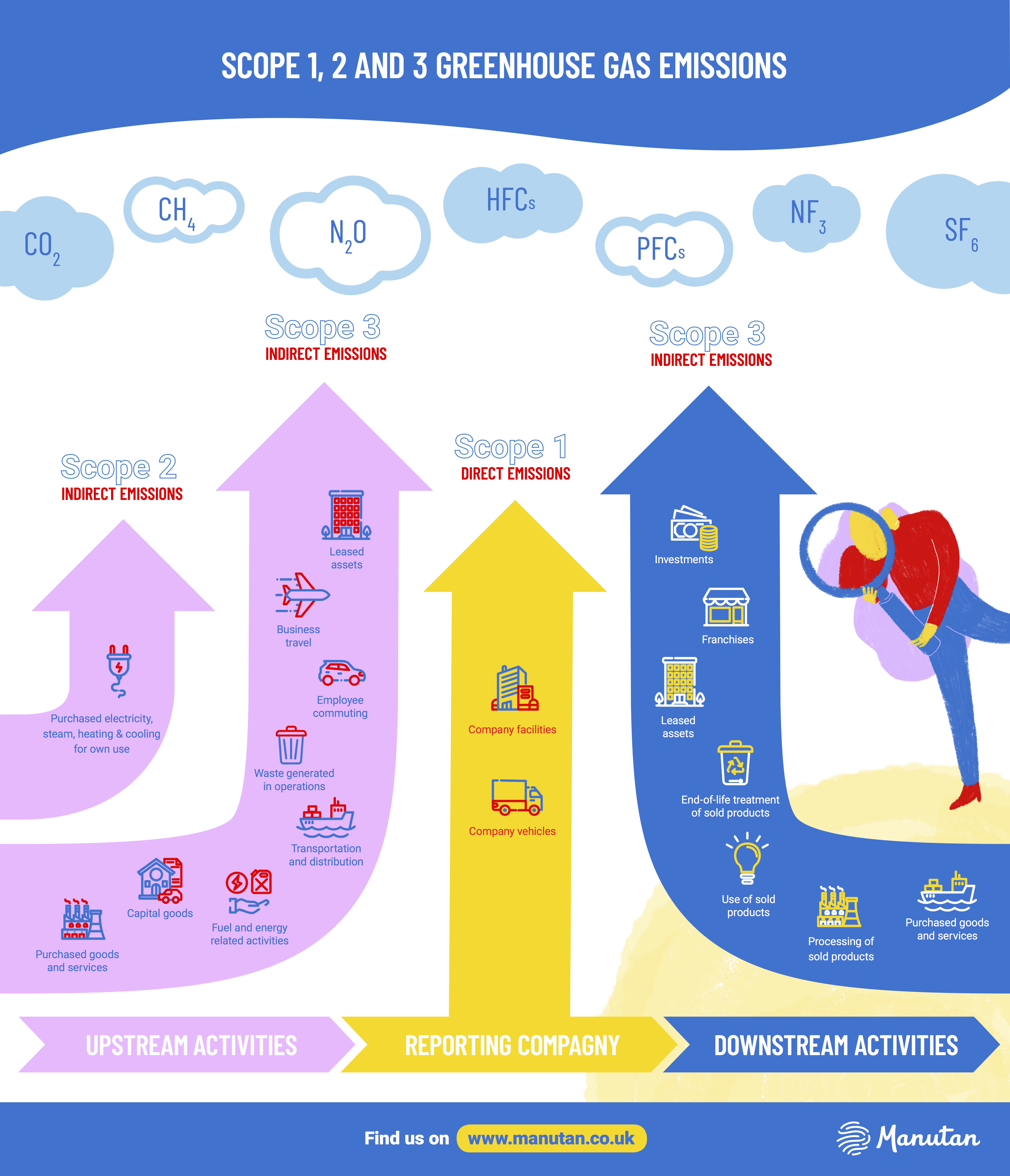
Greenhouse gas emissions (GHGE) resulting from anthropogenic activity (relating to human activity) are growing and reaching new records each year. To reduce global warming, multiple actors – organisations and territories – are committed to decreasing their carbon footprint by working to reduce all of their greenhouse gas emissions. This is achieved by assessing their carbon footprint in line with scopes 1, 2 and/or 3.
Introduced within the framework of the GHG Protocol, this accounting and reporting standard for greenhouse gasses aimed at businesses is internationally recognised. Read on to discover the history and core aspects of the standard for calculating and reporting greenhouse gas emissions for businesses across the world.
Origins of scopes 1, 2 and 3
The World Business Council for Sustainable Development (WBCSD) and the World Resources Institute (WRI) introduced the GHG Protocol at the end of the ’90s. The partnership, which brings together businesses, non-governmental organisations (NGOs) and governments, aimed to establish a framework for the accounting and reporting of greenhouse gasses designed for businesses.
As such, the GHG Protocol incorporates three fields of application for carbon reporting: scope 1, scope 2 and scope 3. By referring to this standard, businesses are able to carry out a carbon report, identify their principal sources of greenhouse gas emissions and develop an effective strategy to reduce their carbon footprint.
This data enables companies to take part in voluntary initiatives, public reports and markets for emission rights, as well as to address regulatory policies implemented in their geographical area.
The standard recognises seven greenhouse gasses covered by the Kyoto Protocol:
- Carbon dioxide (CO2);
- Methane (CH4);
- Nitrous oxide (N2O);
- Hydrofluorocarbon (HFCs);
- Perfluorinated hydrocarbon (PFCs);
- Sulphur hexafluoride (SF6);
- Nitrogen trifluoride (NF3).
Scope 1: direct GHG emissions
This scope refers to direct greenhouse gas emissions: emissions that come from sources owned or controlled by a business. Emissions linked to equipment and facilities belonging to a business, as well as emissions linked to fuel consumed by its vehicles are classed as scope 1.
Emissions linked to physical or chemical treatment, biomass, etc. are also included in this scope, as are ‘fugitive’ emissions, which result from problems concerning airtightness, use of refrigeration and air conditioning devices, etc.
It all depends on the activities of each business. By way of example: a freight service reports its carbon emissions as scope 1, while the business using its lorries for deliveries reports them as scope 3.
Scope 2: indirect GHG emissions linked to energy
This scope covers indirect greenhouse gas emissions linked to the production of electricity, heat, cold, steam, etc. bought/imported or sold/exported by a business. While consuming energy may not emit greenhouse gasses, producing it does. These emissions will naturally depend on the primary energy source used to produce them: petrol, gas, carbon, wind, solar, etc.
Scope 3: all other indirect GHG emissions
This scope covers all other indirect greenhouse gas emissions. This includes emissions resulting from a company’s activities, but which come from sources belonging to, or under the control of, another business. These emissions are not directly linked to the manufacture of a product, but rather to all other phases in its life cycle (from the supply of raw materials to waste treatment). It is generally accepted that scope 3 represents almost 80% to 90% of total emissions generated by a company’s activities[1].
This scope groups together emissions generated throughout the entire value chain. Upstream mainly consists of supplier emissions:
- Procurement of products and services;
- Fixed assets;
- Consumption of fuel and energy upstream;
- Transportation and distribution of goods;
- Waste;
- Employee commuting;
- Business travel;
- Leased assets upstream.
Downstream consists of emissions linked to product and/or service usage and end-of-life:
- Transportation of goods and services;
- Usage, transformation and end-of-life of sold products;
- Leased assets downstream;
- Franchises;
- Investments.
While scope 3 accounts for the majority of carbon emissions, procurement function plays a key role upstream where suppliers are located. Introducing a sustainable procurement approach within a company can absolutely help it reduce its carbon footprint. As a result, the procurement function encourages sustainable consumption, all while responding to new social and environmental requirements.
Through the definition of the various types of emissions (scopes 1, 2 and 3), the GHG Protocol enables the fight against climate change to be harmonised at global level. With strategic influence upstream of the value chain, a company’s procurement function can help it decarbonise, while also protecting resources and the environment.
Once businesses have successfully brought scopes 1 and 2 under control, the challenge shifts to supporting their supplier networks to identify and calculate their carbon emissions so that tailored action plans can be implemented.
- Download our white paper ‘Placing CSR at the core of your company’s procurement policy’
[1] McKinsey & Company, Buying into a more sustainable value chain, 2021








